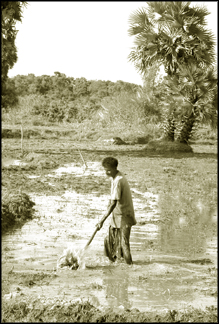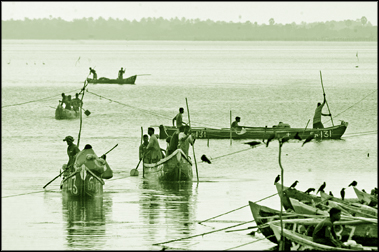Steering a new era of development
North and East will boost economy:
Lakshmi DE SILVA
 |
|
Minister
Ranjith Siyambalapitiya |
The economic outlook of the future of Sri Lanka was predicted to
become positive by the Central Bank and senior Government Ministers
since the war against terrorism was over and even while the war was on
an average macro economic growth rate of over four percent was recorded
for the first and second quarters of the current year. The Daily News
interviewed State Revenue Minister Ranjith Siyambalapitiya to ascertain
the strategies used by the Government to sustain the growth rate and
further develop the dormant regions and sectors to accelerate economic
development. Following are the highlights of the interview:
Q: Now that there is peace in the country and the economic outlook is
positive what strategies will the Government employ to enhance economic
growth?
A: Under the Mahinda Chinthana policy program in the next few years
Sri Lanka would gain more development in agriculture, fisheries and
tourism sectors and would be lucky to receive oil resources as expected.
Sri Lanka’s economy has recorded a 3.5 percent to four percent growth
during the global economic downturn while the developed countries
recorded a minus growth rate. Next year we hope to increase our growth
rate up to six percent or more with the global trends improving.
Now things would change for the betterment in agriculture, fisheries
and tourism sectors especially in the Northern and Eastern regions. The
Government had allocated Rs. three billion for fishermen and farmers in
the Northern province to uplift their livelihood. Permanent residents of
the North could apply for loans under a special scheme and they could
get up to Rs. 300,000 on a 10 percent or a lower interest rate from any
of the public sector banks.
Q: For the past three decades there was very little or no
contribution from the East and North to the national economy due to
terrorism. Now there could be progress of these regions. How would the
revival of economic activity be channeled for a greater share of growth?
A: The tourism sector in the Northern and Eastern parts of the
country too would be developed with special concessions to entrepreneurs
to build new hotels. The contribution from the North and East to the
economy would be like a leap forward. The two provinces are fertile and
rich.
The damaged roads, bridges and electricity in those two provinces had
to be reconstructed and restored and the Government has allocated Rs. 40
billion. Infrastructure development in the two provinces has been
accelerated and not only the residents but also the entire country would
gain the benefits in the future.
Q: How soon normality would return to the North and East?.
A: We cannot do wonders within a short time from May to September but
in the years to come, a gradual development progress could be seen in
all the sectors. Other than the defence expenditure we had to spend Rs.
2.5 billion on welfare of the IDPs. People should learn to look at those
developments with a balanced view without taking malicious corners that
the Opposition was trying to spread by creating false documentations
against the Government.
The North and East are full of resources. The farmers were once
self-sufficient and hardworking. Their contribution would certainly not
add just development but would be a leap forward to development and it
was just like letting loose someone who had been tied for many years.
Even the fisheries industry that was crippled due to terrorist
activities would come back to its normal production with two thirds of
the sea area being utilized for fishing industry from all parts of the
country.
 |
 |
|
Agriculture
and fisheries in the North gaining a new lease of life. File
photo |
The factories that were closed in Kankesanthurai, Valachchenai,
Pulmodai would be started and it would create more employment
opportunities. All in all these facts would show you that development
and employment would go hand in hand providing more benefits to the
people.
The factors that were against our economic development during the
past three decades would now turn for the betterment and would lead
towards a better future.
Q: Does the economic growth mean that people having a better living
standard than before? If so what is the increase in their incomes?
A: The per capita income had reached 2,014 US dollars at the end of
2008 but there was a vast disparity. There is a percentage of low income
groups of people . Therefore the Government had provided many relief
measures, through concessions like Samurdhi, free education, health and
other social benefit schemes. It also provides better transport and
improved roads to more people in rural areas. Development schemes like
Moragahakanda built with the tax payers’ money mainly from Colombo would
provide benefits to rural farmers. Those are indirect benefits and are
not reckoned in monetary form but beneficial to people. Also the amount
of concessions has increased from 2004.
Q: Any other fiscal measures you propose to accelerate the economic
growth and development?
A: The tax system would be changed and a tax commission would be
appointed with professionals and representative of tax payers which
would make recommendations to have a simple tax system. The Government
expects to increase direct taxes and reduce indirect taxes.
Q: There was much criticism in certain quarters about the foreign
reserves and there was also an allegation that the Government was
selling gold reserves. Any comments?
A: The position of Sri Lanka’s foreign reserves is officially
announced by the Central Bank monthly. In March this year, foreign
reserves declined to 1.2 billion dollars. There was nothing to hide but
we disclosed the truth. And now we have a stronger position with dollar
4 billion foreign reserves .Therefore it was nothing new but a formal
announcement.
Selling of gold reserves was also another story cooked up by the
Opposition Leader who went round the world some time back trying to
influence foreign authorities not to release the IMF funds to Sri Lanka.
I think it was also a conspiracy against the country by him who only
wants to grab power by betraying the country.
When the Government wanted to obtain a loan from the HSBC the UNP led
a campaign to stop it. When the Government was trying hard to get the
loan the UNP with its full force tried to prevent it. Finally the
Government got the loan but at high interest rate of 8.5 percent.
We could have got it at least for 7.5 percent interest if not for the
UNP’s bad propaganda drive. Even if the UNP comes to power they would
also have to pay that interest rate.
Q: Can you comment on the inflation rate?
A: Sri Lanka’s inflation rate went up to 28.4 percent last year but
now the prices of goods have come down and we hope to bring the
inflation to one percent or less than that.
|



